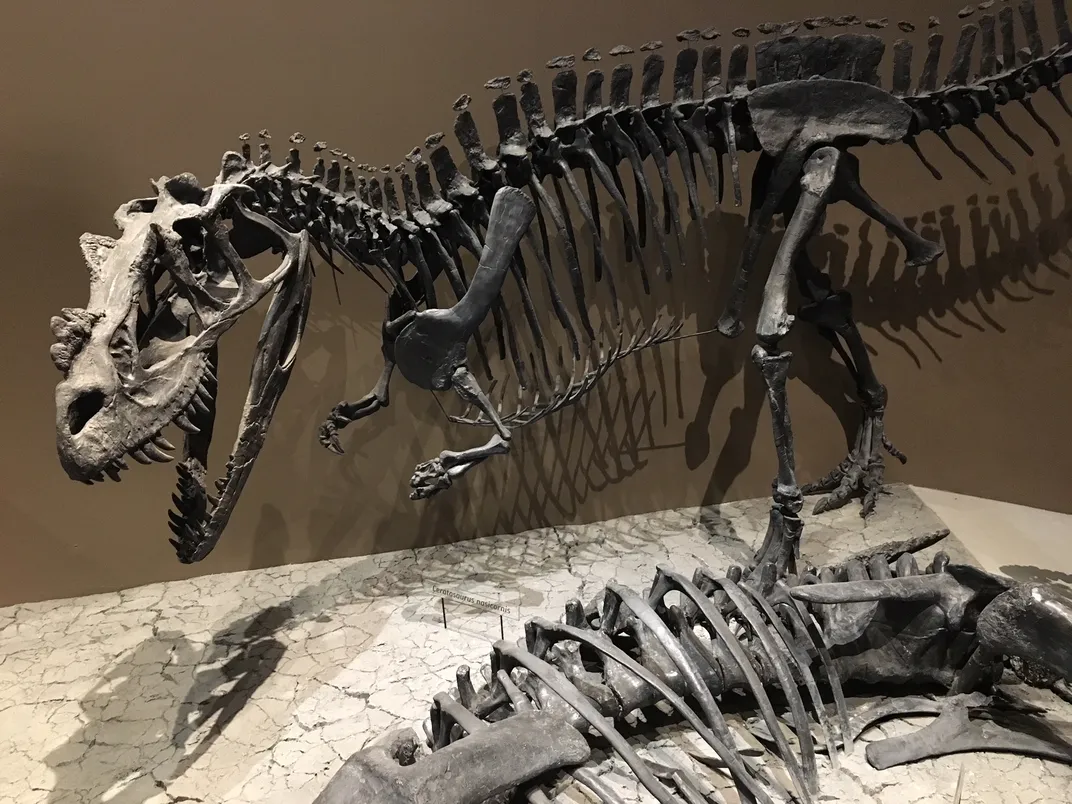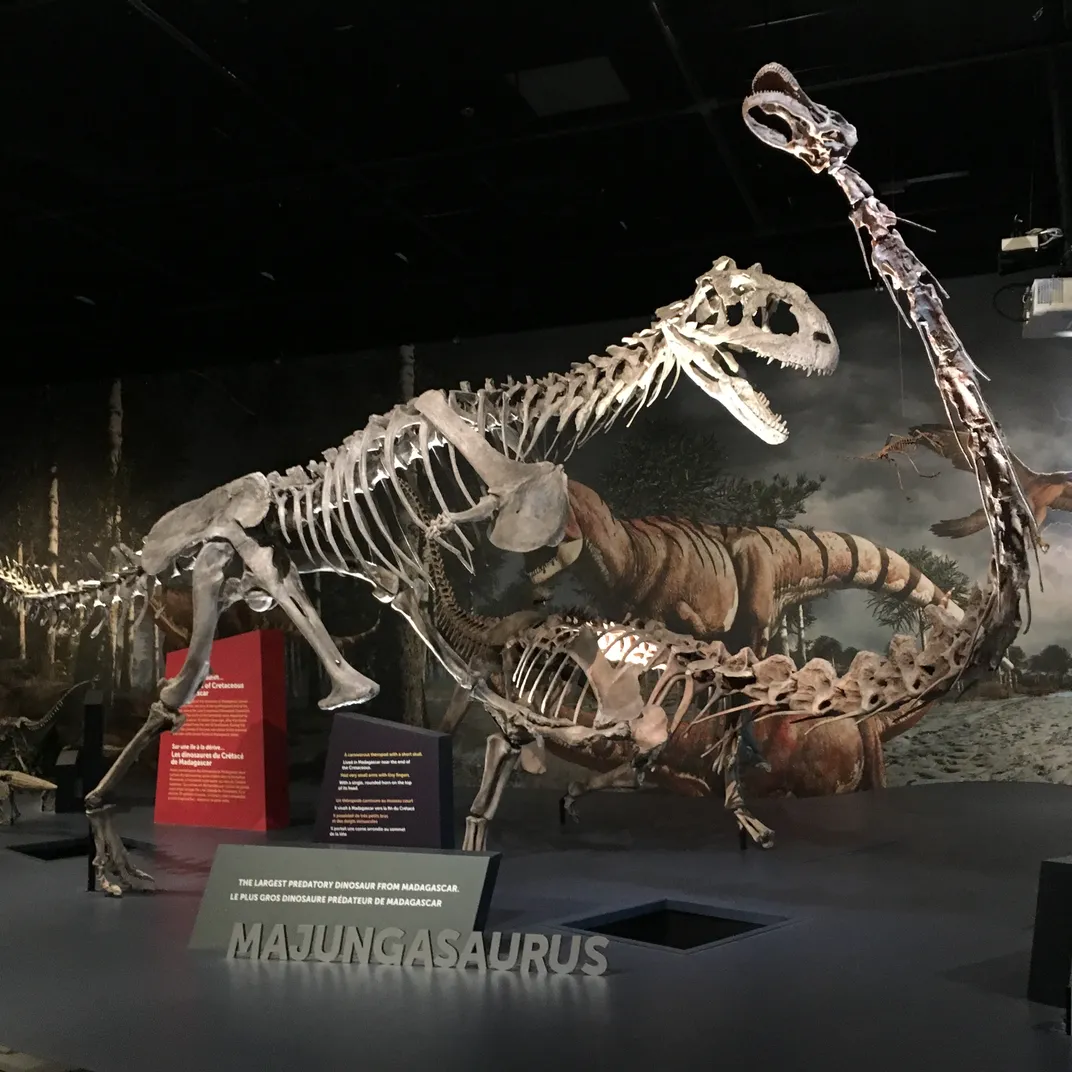Flesh-Ripping Dinosaurs Replaced Their Teeth Multiple Times a Year
A high rate of tooth turnover gave these prehistoric carnivores an edge
:focal(1651x952:1652x953)/https://tf-cmsv2-smithsonianmag-media.s3.amazonaws.com/filer/9a/fb/9afb93b5-c5a8-4299-8be2-d9b3a8508b26/majungasaurus_masiakasaurus_rapetosaurus.jpg)
For carnivorous dinosaurs, staying sharp was of the utmost importance. Whether they were slicing flesh from the flanks of their prey or crushing the bones of their victims into splinters, the business of eating other animals can be tough on the teeth.
Like all toothy dinosaurs, prehistoric carnivores replaced their teeth throughout their lives. New cutlery constantly grew in their jaws to push old or broken teeth out of the way. And a new study published today in PLOS ONE reveals how often three Mesozoic meat eaters replaced their chompers. The evidence that these carnivores grew new teeth several times a year also can tell us new things about how these animals hunted and fed.
The research, published by Adelphi University paleontologist Michael D’Emic and colleagues, continues previous work that examined the teeth of herbivorous dinosaurs. In 2013 D’Emic and coauthors calculated that the long-necked Jurassic herbivores Camarasaurus and Diplodocus replaced one tooth every 62 days and 35 days, respectively. Plant food can be abrasive, wearing down teeth quickly, and so herbivorous dinosaurs required a constantly renewed supply. But what about the carnivores?
While at Stony Brook University, D’Emic saw a wealth of Majungasaurus teeth that had been shed while the dinosaurs were alive. This dinosaur was the apex predator of its time, reaching about 20 feet in length and weighing roughly a ton. “There are lots of other species known from the same formation and area in Madagascar, but their shed teeth are not incredibly abundant, so I thought there must be something unique about Majungasaurus itself,” D’Emic says.

The huge sample size of tooth fossils offered the opportunity to study Majungasaurus—which lived at the end of the Cretaceous, up to the impact event that wiped out the non-avian dinosaurs 66 million years ago—the same way the team studied long-necked herbivores. The teeth of the Jurassic-era predators Allosaurus and Ceratosaurus, which lived about 150 million years ago, were added to the study set to see how meat eaters from different times and branches of the dinosaur family tree compared to each other.
The researchers used computerized tomography (CT) scans to look the dinosaurs in the mouth, producing images that revealed the layers of multiple dinosaur jaws. Dinosaur teeth are stacked like ice cream cones as they develop inside the jaw, and microscopic details allow paleontologists to estimate how long it took for each individual tooth to develop and replace the one above. The researchers developed a new technique to estimate tooth formation from tooth size without cutting into or destroying the fossil itself. “We want to be able to say a tooth of ‘x’ shape and size formed in ‘y’ number of days,” D’Emic says.
Estimates of tooth growth rely on visible lines that are thought to be laid down daily, but as University of Alberta paleontologist Aaron LeBlanc notes, there’s a great deal of variation in living animals.
“Mammals leave lines in their teeth that can be deposited every few hours, daily, over five- to eight-day periods, or even longer, and we have no idea why that natural variation exists,” LeBlanc says. Even less is known about modern reptiles, and future research may alter some of the tooth formation time estimates for dinosaurs. Still, comparing the new results to what has been found before, it seems that all three carnivores in the study replaced their teeth at a relatively quick rate.
/https://tf-cmsv2-smithsonianmag-media.s3.amazonaws.com/filer/14/7b/147b4df8-1ea8-41c4-a480-e28ddcfc8356/allo_cerato_cover_art_original.jpg)
The paleontologists found that the Jurassic carnivores Allosaurus and Ceratosaurus had tooth replacement rates of about 100 days, while the Cretaceous Majungasaurus had a much faster replacement rate of about 56 days. “I would have predicted from the incredible abundance of shed Majungasaurus teeth that it replaced its teeth quickly, but I couldn’t have imagined how fast,” D’Emic says. This dinosaur replaced its teeth at rates similar to herbivorous species that kept up quick turnover, and, the researchers estimate, about 14 times faster than the bone-crushing Tyrannosaurus.
But why was Majungasaurus so different from other carnivores? Previous work on theropod dinosaurs focused on the famous tyrannosaurs which replaced their teeth slowly. But tyrannosaurs’ slow rate of tooth replacement might be specialized to the species.
“With this new dataset, it looks like most dinosaurs had high replacement rates regardless of diet,” says University of British Columbia paleontologist Kirstin Brink. Likewise, Brink notes, little is known about how dinosaur tooth replacement may have changed during the life of an individual animal.

Even taking these caveats into account, Majungasaurus remains an outlier even among other carnivores, which raises the question of what the dinosaur was doing differently. The high rate of tooth turnover could offer clues about the animal’s diet. During its time on Cretaceous Madagascar, Majungasaurus lived in a harsh environment that experienced strong swings between wet and dry seasons.
“We know that it frequently scraped and cracked bones with its teeth, because there are scratches and gouges on lots of bones from the formation that have the same spacing as Majungasaurus teeth,” D’Emic says. While other carnivorous dinosaurs may have largely avoided biting on bone, it seems that Majungasaurus more frequently crunched the calcium-rich morsels. “This would have necessitated high tooth replacement rates because Majungasaurus teeth are small with extremely thin enamel,” D’Emic says.
Additional studies will throw the teeth of carnivores into greater context. Almost nothing is known about the tooth replacement rates of dinosaurs that lived earlier in the Jurassic or in even older times during the Triassic, LeBlanc says. Specimens from these ancient times are relatively scarce, making it difficult to study early dinosaurs in detail.
As similarities and differences across the dinosaur family tree crop up, however, it’s possible to investigate not only how a dinosaur’s tooth shape related to its diet, but also the way those teeth grew and were replaced. With new research techniques and hypotheses to test, paleontologists will keep tracing the cutting edge.
/https://tf-cmsv2-smithsonianmag-media.s3.amazonaws.com/accounts/headshot/RileyBlack.png)
/https://tf-cmsv2-smithsonianmag-media.s3.amazonaws.com/accounts/headshot/RileyBlack.png)